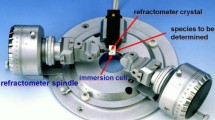Abstract
Barbiturates I and II have been synthesized as maroon red and red orange coloured solids by mixing the ethanolic solutions of 2-chloro-1,3,5-trinitrobenzene (TNCB), pyrimidine-2,4,6(1H,3H,5H)-trione [barbituric acid (BA)] and 8-hydroxyquinoline and 1,3-dichloro-4,6-dinitrobenzene (DCDNB), 1,3-dimethylpyrimidine-2,4,6(1H,3H,5H)-trione(1,3-dimethylbarbituric acid) and 8-hydroxyquinoline respectively. The structures of these two barbiturates have been predicted from the spectral studies (UV-VIS, IR, 1H NMR, 13C NMR, mass) and elemental analysis. Qualitative tests have been carried out to infer the presence of nitrogen and nitro groups and also chlorine atom in barbiturate II. Slow evaporation of ethanol-dimethylsulphoxide/ethanol solutions of barbiturate I/barbiturate II at 293 K yielded good for X-Ray diffraction crystals. Single crystal X-ray diffraction studies of the crystals further confirm the putative structures of the barbiturates. The asymmetric unit of the barbiturate I comprises of 8-hydroxyquinolinium cation, 5-(2,4,6-trinitrophenyl) barbiturate anion and a molecule of dimethylsulphoxide (DMSO), which is used as a recrystallizing solvent. It crystallizes in the triclinic system with space group \(P\bar 1\) (centrosymmetric). Barbiturate II crystallizes in the orthorhombic system with space group P212121 (non-centrosymmetric). Barbiturates I and II are stable towards an impact sensitivity test, when a weight of 2 kg mass hammer is dropped from a height of 160 cm of the instrument. TGA/DTA analyses at four different heating rates (5, 10, 20, and 40 K/min) imply that they undergo exothermic decomposition (∼85%) in three different stages between 273 and 873 K. Activation energies for these decomposition processes have been calculated by employing Kissinger and Ozawa plots. Impact sensitivity test and activation energies have revealed that the titled barbiturates are insensitive high energy density materials (IHEDMS).
Similar content being viewed by others
References
R. Meyer, J. Kohler, and A. Homburg, Explosives, 6th ed. (Wiley-VCH, Hamburg, 2007).
S. G. Cho, Bull. Korean Chem. Soc. 30, 177 (2009).
J. P. Agrawal, High-Energy Materials (Wiley-VCH, Hamburg, 2010).
E. E. Gilbert and N. J. Morristown, US Patent No. 3941812 (1976).
A. J. Bellamy, D. S. King, and P. Golding, Propellants Explos. Pyrotech. 29, 166 (2004).
H. S. Jadhav, M. B. Talawar, R. Sivabalan, et al. Indian J. Heterocycl. Chem. 15, 383 (2006).
Z. Ge, S. Qiu, J. Jiang, and X. Wang, Huozhayao Xuebao 31, 177 (2008).
H. Oestmark, S. Walin, and P. Goede, Centr. Eur. J. Energetic Mater. 4, 83 (2007).
D. M. Badgujar, M. B. Talawar, S. N. Asthana, and P. P. Mahulikar, J. Hazardous Mater. 151, 289 (2008).
T. M. Klapötke, Chemistry of High-Energy Materials (Walter de Gruyter, Berlin, 2011).
P. Politzer, M. C. Concha, M. E. Grice, et al., Theochem. 452, 75 (1998).
S. M. Peiris, C. P. Wong, and F. J. Zerilli, J. Chem. Phys, 120, 8060 (2004).
U. R. Nair, S. N. Asthana, A. S. Rao, and B. R. Gandhe, Defence Sci. J. 60, 137 (2010).
J. C. Ritter, US Patent No. US8003831B1 (2011).
A. I. Vogel, Text Book of Practical Organic Chemistry, 4th ed. (Longman, London, 1978).
H. E. Kissinger, Anal. Chem. 29, 1702 (1957).
T. Ozawa, Bull. Chem. Soc. Jpn. 38,1881 (1965).
Bruker APEX2, SAINT-Plus and SADABS (Brunker AXS, Madison, Wisconsin, USA, 2004).
A. Altomare, G. Cascarano, C. Giacovazzo, and A. Guagliardi, J. Appl Crystallogr. 26, 343 (1993).
G. M. Sheldrick, Acta Crystallogr. A 64, 112 (2008).
L. J. Farrugia, J. Appl. Crystallogr. 30, 56 (1997).
C. F. Macrae, I. J. Bruno, J. A. Chisholm, et al., J. Appl. Crystallogr. 41, 466 (2008).
R. M. Silverstein and F. X. Webster, Spectrometric Identification of Organic Compounds (Wiley, New York, 2004) p. 103.
E. Ramachandran, K. Baskaran, and S. Natarajan, Cryst. Res. Technol. 42, 73 (2007).
W. Kemp, Organic Spectroscopy (Palgrave, New York, 1991), p. 192.
D. W. Bennett, Understanding Single Crystal X-Ray Crystallography (Wiley-VCH, Hamburg, 2010) p. 164.
M. Buvaneswari and D. Kalaivani, Acta Crystallogr. E 67, o1433 (2011).
M. Buvaneswari and D. Kalaivani, Acta Crystallogr. E 67, o3452 (2011).
V. Manickkam and D. Kalaivani, Acta Crystallogr. E 67, o3475 (2011).
R. Babykala and D. Kalaivani, Acta Crystallogr. E 68, o2941 (2012).
D. Kalaivani, M. Buvaneswari and S. Rajeswari, Acta Crystallogr. E 68, o29 (2012).
R. Babykala and D. Kalaivani, Acta Crystallogr. E 68, o541 (2012).
R. Babykala and D. Kalaivani, Acta Crystallogr. E 69, o398 (2013).
P. Agrawal and R. D. Hodgson, Organic Chemistry of Explosives (Wiley, 2007).
J. P. Agarwal, Prog. Energy Combust. Sci. 24, 1 (1998).
P. P. Politzer, J. S. Murray, J. M. Seminario, et al. J. Mol. Struct. 573, 1 (2001).
A. K. Sikder, R. B. Salunke, and N. Sikder, New J. Chem. 25, 1549 (2001).
Author information
Authors and Affiliations
Corresponding author
Additional information
The article is published in the original.
Rights and permissions
About this article
Cite this article
Manickkam, V., Devi, P.P. & Kalaivani, D. Synthesis, characterization, thermal behaviour and single crystal X-ray analysis of two new insensitive high energy density materials [8-hydroxyquinolinium 5-(2,4,6-trinitrophenyl)barbiturate (I) and 8-hydroxyquinolinium 5-(5-chloro-2,4-dinitrophenyl)-1,3-dimethyl barbiturate (II)]. Crystallogr. Rep. 59, 1042–1050 (2014). https://doi.org/10.1134/S1063774514060200
Received:
Published:
Issue Date:
DOI: https://doi.org/10.1134/S1063774514060200




